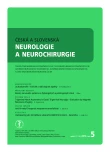Polyuria in Neurocritical Care – a Case Report
Authors:
V. Špatenková 1; P. Škrabálek 2
Authors‘ workplace:
Krajská nemocnice Liberec, a. s.
Neurocentrum, Neurointenzivní jednotka
1; Krajská nemocnice Liberec, a. s.
Oddělení klinické biochemie
2
Published in:
Cesk Slov Neurol N 2014; 77/110(5): 647-649
Category:
Case Report
Overview
Polyuria is often seen in neurocritical care patients and can cause severe water and sodium imbalance. There are two major mechanisms causing the loss of water via the kidneys. The loss may be either due to osmotic or water diuresis. Central diabetes insipidus is a typical water diuresis, with free water losses causing hypernatremia in acute brain disease. Sodium diuresis occurs in cerebral salt wasting syndrome and causes hypoosmolal hyponatremia. One of the aims of neurocritical care is to prevent iatrogenic dysnatremias by careful management of polyuria. This requires correct diagnosis of the type of diuresis and differentiation of the possible cause – whether this is the organism’s compensatory response to higher fluid or osmotic agent intake or acute brain damage. We present a case of a 34‑year‑ old female patient with subarachnoid hemorrhage and iatrogenic hypoosmolal hyponatremia, iatrogenic drug‑associated SIADH (syndrome of inappropriate secretion of antidiuretic hormone) caused by erroneous administration of desmopressine acetate in polyuria with free water diuresis.
Key words:
polyuria – hyponatremia – hyper-natremia – neurocritical care
The authors declare they have no potential conflicts of interest concerning drugs, products, or services used in the study.
The Editorial Board declares that the manuscript met the ICMJE “uniform requirements” for biomedical papers.
Sources
1. Andreoli TE. The polyuric syndromes. Nephrol Dial Transplant 2001; 16 (Suppl 6): 10– 12.
2. Oster JR, Singer I, Thatte L, Grant‑ Taylor I, Diego JM.The polyuria of solute diuresis. Arch Intern Med 1997; 157(7): 721– 729.
3. Wong MF, Chin NM, Lew TW. Diabetes insipidus in neurosurgical patients. Ann Acad Med Singapore 1998; 27(3): 340– 343.
4. Spatenkova V, Bradac O, Kazda A, Suchomel P. Central diabetes insipidus is not a common and prognostically worse type of hypernatremia in neurointensive care. Neuro Endocrinol Lett 2011; 32(6): 879– 884.
5. Tisdall M, Crocker M, Watkiss J, Smith M. Disturbances of sodium in critically ill adult neurologic patients: a clinical review. J Neurosurg Anesthesiol 2006; 18(1): 57– 63.
6. Shoker AS. Application of the clearance concept to hyponatremic and hypernatremic disorders: a phenomenological analysis. Clin Chem 1994; 40(7): 1220– 1227.
7. Sherlock M, O‘Sullivan E, Agha A, Behan LA, Owens D, Finucane F et al. Incidence and pathophysiology of severe hyponatraemia in neurosurgical patients. Postgrad Med J 2009; 85(4): 171– 175. doi: 10.1136/ pgmj.2008.072819.
8. Rahman M, Friedman WA. Hyponatremia in neurosurgical patients: clinical guidelines development. Neurosurgery 2009; 65(5): 925– 935.
Labels
Paediatric neurology Neurosurgery NeurologyArticle was published in
Czech and Slovak Neurology and Neurosurgery

2014 Issue 5
Most read in this issue
- Czech Training Version of the Montreal Cognitive Assessment (MoCA‑ CZ1) for Early Identification of Alzheimer Disease
- Leukodystrophies – Clical and Radiological Findings
- Barriers of Nervous System under Physiological and Pathological Conditions
- Surgical Treatment of Supratentorial Cortico‑ subcortical Cavernous Malformation
